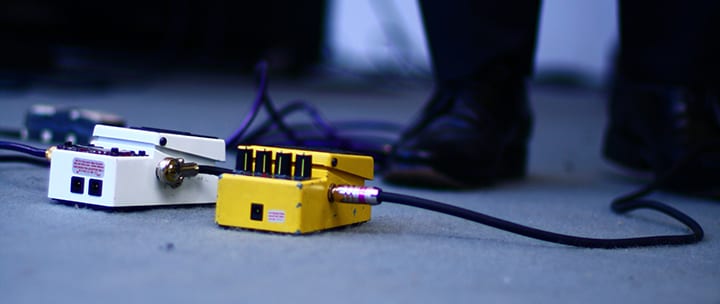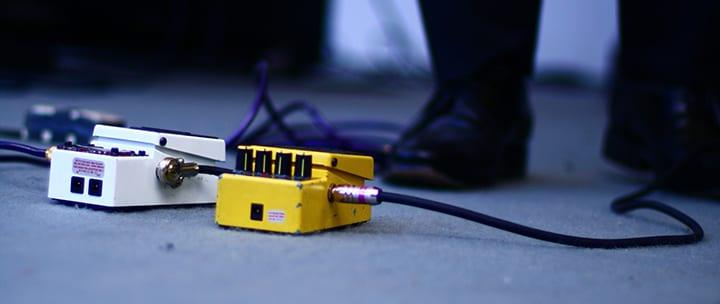 With so much equipment available for guitar players, how do you know what’s worth your hard-earned money? In this guest post, North Wales, PA teacher Nathan D. shares what you need to know about finding the best guitar effects pedals and more…
With so much equipment available for guitar players, how do you know what’s worth your hard-earned money? In this guest post, North Wales, PA teacher Nathan D. shares what you need to know about finding the best guitar effects pedals and more…
In the never-ending quest for the guitar tone of their dreams, guitarists will spend countless hours experimenting with pickups, cables, amps, speakers, and much more. And at some point if you have an electric guitar, you’ll get the uncontrollable urge to try some effect pedals. They’re adorable, mysterious, and really fun, but some can be downright expensive.
Where Do I Even Begin?
As you experiment with guitar effects pedals, I recommend starting with the standard, simple effects, like distortion and reverb (if your amp doesn’t already do it very well). Moving forward, try choruses and delays. Test it out in the store with a similar setup to (or bring) your own. Don’t forget to try all of your pickup selections and play with your volume and tone knob. Compare and contrast with what you have and what you’re looking for. Don’t try just one specific pedal for the effect you want, try as many as possible!
Used pedals are typically well-abused, so be wary of noise and crackling. Bring dependable cables to test them. The salesperson may swear that it’s their test cables making the noise, and that they have no others to provide you with. Make sure you have some kind of warranty from the shop before any purchase. If you find your dream pedal on eBay, make sure the seller accepts returns (and that shipping costs don’t burn you).
You might find conflicting reviews for many pedals (such as MXR and Danelectro), and many pedals from the same brand that have varying reviews as well. Be wary of manufactures that make various products. Zoom makes a great portable recorder, but many lousy pedals. Ibanez makes great guitars, but some really bad effects. That’s why the demo chain at your guitar store has mostly pedal-specific, high-selling manufactures like Boss and DigiTech.
Nothing is worse than a budget distortion pedal that is, and sounds like, thin plastic. Save up to buy decent ones that are well-received and can take a hit (like a Boss, no pun intended!).
However, some cheaper pedals may surprise you. Behringer makes some great stuff for the price — just make sure to test it out, because budget manufactures with foreign manufacturing tend to let more defects slide through to keep prices low.
Avoiding a Bad Case of G.A.S.
Pedals are a guitarist’s number one gateway to Gear Acquisition Syndrome, or G.A.S. (a common condition in any hobby and profession). You spend all of your money on junk you never use, and all of your time researching it, while you should concentrate on practicing and playing out!
When you take a break, do something that doesn’t cause you to spend money, like exercising or reading an actual book, instead of flipping through the latest gear catalog and circling items that make you go “oooh!” with a pen or highlighter.
You don’t need a $400 effect pedal that makes your guitar sound like a synth trumpet. Please recycle that catalog before one of your friends or bandmates comes along and starts reading it. A handful of people who buy pedals like these may use them for a few seconds on one song, which is not really worth the hours of research and hundreds of dollars.
Stay Within Your Limited Budget
You don’t need the latest and greatest model of the best guitar effect pedals, especially when you get into larger multi-effect ones. The manual that accompanies this caliber of pedal is typically a quarter- to a half-inch thick (in one language). They are complicated, and will take weeks of fiddling around to get used to and months to master, as you learn each effect independently and then in conjunction with each other (plus signal order and other jargon). Ask a sales rep for help with these if there’s a test model.
I have a used Boss GT-6 that I bought more than 15 years ago as an upgrade to the poor DOD TEC-8 (DOD is a budget subdivision of DigiTech). I use it daily and have learned it inside and out. A friend insisted on buying the newest version of the pedal when it came out, and even applied for the store credit card to purchase it. It was so complicated that he only uses maybe an eighth of the effects, and never read the manual. He spent hundreds more than I did for mine, just because he had to have the newest thing and get it brand new. There was a price drop and rebate on the pedal three weeks later. So early adopters, be warned! There is no shame in having an older pedal, as many give you most of the same effects you’re looking for in the later versions.
Sometimes more complicated amps, like those by Line 6, have their own multi-effect boards. If you enjoy everything your amp offers already, try finding the pedal for it used or refurbished.
Finally, if the pedal hasn’t been made since the ’80s or ’90s, beware! This was the pivotal time to launch countless pedals onto the market that disappeared into obscurity for good reasons. If it’s still available new, it’s good for someone, just not necessarily for you and your tastes.
Now That You Know, Go!
OK, you mad scientists, get out there and experiment! Find your dream tone!
 Nathan D. teaches guitar, bass, drums, music recording, and more in North Wales, PA. He is an ASCAP songwriter, and has played guitar and bass for more than 17 years and drums for about 15 years. Learn more about Nathan here!
Nathan D. teaches guitar, bass, drums, music recording, and more in North Wales, PA. He is an ASCAP songwriter, and has played guitar and bass for more than 17 years and drums for about 15 years. Learn more about Nathan here!
Photo by heuristicus
Suzy S.

